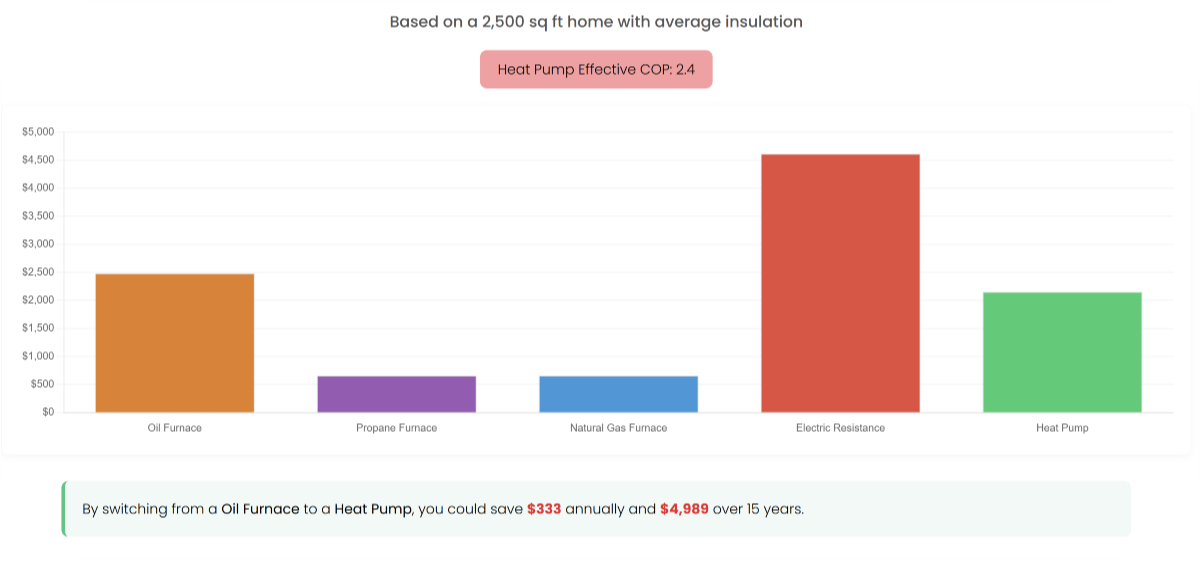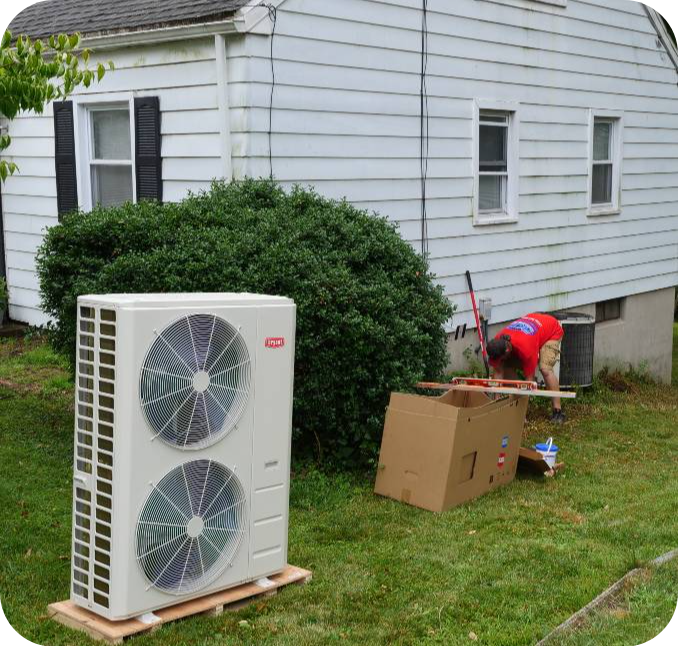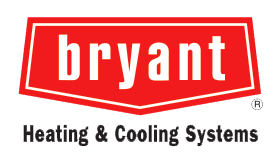100-year-old home in Linntown converts from oil to Bryant Mini-Split Heat Pumps in every space.
The owners of this classic Lewisburg, PA home took ownership of this special home in Linntown, there was no question that they would convert their heating system from fossil fuel to electricity and get world-class air conditioning with a modern, multi-zone heat pump solution.
Case Study Overview: Converting a 4-bedroom home from oil to electric heat pumps in Lewisburg, PA
- 75% reduction in energy bills
- Shut off the rooms not in use
- No noise at all
- 6 zones cover 4 bedrooms, the kitchen, dining room, and living room.
Tired of Oil or Propane?
- You don’t have to spend thousands on home heating oil or propane every winter.
- You don’t have to heat and cool empty rooms.
- You don’t have to lose 20% of your heating and cooling through leaky ductwork.
Modern ductless heat pumps are the answer.
We’d love to help you make the jump from fossil fuel to clean, electric heating and cooling. Tell us a little about yourself, and we’ll reach out for a friendly chat about your options.
Installation Profile: Lewisburg, PA Two-story single home
Previous System
- 18-year-old central air (first floor only)
- Oil boiler
- R-22 refrigerant (phased out)
Bryant Ductless Solution
- High-wall unit for all four bedrooms
- High-wall unit for the first-floor living space
- Two outdoor units
- No resistance heat required
Based on $2.87/gallon for oil and 18 ¢/kWh for electricity, this shows how the cost of heating with a heat pump compares to other sources of heat.


Technical Specifications: Modern Heat Pump Evolution
- Variable-Speed Technology: Inverter-driven compressor modulates output based on demand, eliminating inefficient on/off cycling
- Low-Temperature Operation: Advanced refrigerant management enables heat extraction from ambient air at 0°F and below
- HSPF (Heating Seasonal Performance Factor): Latest Bryant models achieve ratings exceeding 10.0
- SEER (Seasonal Energy Efficiency Ratio): Cooling efficiency ratings up to 30+ SEER
- Refrigerant Transition: R-410A refrigerant offers zero ozone depletion potential
Property Value & ROI Analysis
Homeowner Benefits (Lewisburg, PA Single Home, Multi-Zone Case Study):
- Increased Property Value: Modern HVAC system adds market appeal
- Reduced Maintenance Calls: Eliminates the burning elements that frequently failed or required annual maintenance
- Flexibility=Savings: Only heats the room or rooms in use. Dramatic energy savings.
- Long-Term Investment: Over 15-20 years, this is a cash flow positive heating solution that also cools
Energy Cost Projections:
- Eliminate 80,000 pounds of retail, local carbon emissions annually
- Elimination of home heating oil cost ($2,500/year)
- Average annual savings: $1,200 or more by not conditioning rooms not in use
- Federal tax credits and utility rebates were available to reduce the initial investment
System Configuration: Lewisburg, PA Installation
Two Outdoor Condensers Power:
→ High-wall unit (all four bedrooms): now they can be heated and cooled as needed
→ a single high-wall unit to condition the kitchen, dining room, and living room spaces
→ Separate hand-held remote controls for each indoor air handler
Understanding this Homeowner’s Savings
Energy Consumption Breakdown
Study Methodology:
- Period analyzed: 6 months (cooling and shoulder seasons)
- Comparison years: 2020 (old system) vs 2022 (Bryant ductless)
- Variables controlled: Similar weather patterns, occupancy, usage habits
Key Factors Contributing to 32% Reduction:
- Variable-Speed Operation: Eliminates energy spikes from on/off cycling
- Zone Control: Conditions only occupied spaces
- Improved SEER/HSPF: Modern efficiency ratings vs 18-year-old technology
- No Duct Losses: Direct room delivery eliminates 20-30% typical duct losses
Technical Insights
Q: How do heat pumps produce heat at 0°F when traditional models fail at 35°F?
A: Advanced Bryant heat pumps utilize enhanced vapor injection (EVI) technology and variable-speed compressors. This allows the refrigerant cycle to maintain efficiency at much lower temperatures by managing compression ratios and refrigerant flow rates dynamically. The system can extract ambient heat energy even when outdoor temperatures approach zero.
Q: What makes the 32% energy reduction sustainable long-term?
A: Unlike window units that degrade rapidly (10-15% efficiency loss over 5 years), Bryant ductless systems maintain performance through:
- Sealed refrigerant systems with no seasonal disconnection
- Protected outdoor components designed for year-round operation
- Self-diagnostic capabilities that maintain optimal performance
- No mechanical wear from installation/removal cycles
Q: How does eliminating resistance heat impact overall efficiency?
A: Resistance heating operates at 100% efficiency (1:1 energy conversion), while modern heat pumps achieve 300-400% efficiency through heat transfer. By maintaining heat pump operation to 0°F, the Bryant system avoids the significant energy penalty of resistance strips that traditional heat pumps require below 35°F, resulting in 3-4x lower heating costs during cold weather.
“Take a look at what the HSPF ratings are, the heat seasonal performance ratings. Take a look at the SEER ratings and take a look at what you’re going to get in the long run, so far as the return on investment for the consumer.”
– David Lamb, Peirce Phelps (Bryant Product Manager)
Additional Considerations for Second-Floor Applications
The State College case study highlights a common challenge in Cape Cod and similar home designs. Traditional ducted systems often fail to adequately condition second floors due to:
- Insufficient duct sizing in retrofit applications
- Natural stratification of heated/cooled air
- Extended duct runs resulting in thermal losses
- Inadequate return air pathways
Bryant ductless systems solve these challenges through direct-room delivery and independent zone control, ensuring optimal comfort while maximizing efficiency.
"So Much Better!"
I never thought my second floor could ever be this good! Everyone gets to set the temperature in their own room.
Barbara S.
Philadelphia, PA
"The Finishing Touch"
After a renovation, our first floor never felt right anymore. The mini split solved that problem instantly.
Jon T.
Philadelphia, PA
"So Quiet!"
After using window air conditioners for years, I couldn't beleive how quiet the mini split is! We stay cool, we can talk and watch TV and sleep in peace!
Kristen M.
Philadelphia, PA
"Fast Installation"
Workers were in and out of our home in a day and they left the place spotless. This was the easiest experience I've ever had with a contractor.
Bill F.
Philadelphia, PA
"Lower Electric Bills!"
We used to put aside extra money for gas in the winter and electric in the summer. Not anymore! I can't believe how well these work and how much lower our bills are now.
Natasha K.
Philadelphia, PA
Our Promise to Your Family
Let’s chat about those questions you might have about ductless mini-split systems! We love helping neighbors like you find the perfect comfort solution for your home.
We understand that your home is where your heart is. That’s why we’re committed to helping you make every corner of it feel just right. A Bryant ductless system brings gentle comfort to those special spaces where you and your loved ones gather, create memories, and share life’s precious moments.
Every family deserves a home that feels comfortable and welcoming in every room, all year round. We’d be honored to help make that happen for you.
Installation Process: Timeline & Procedures
Phase 1: Initial Contact & Contractor Assignment
Action required: Submit contact information via online form
Response time: Immediate to 24 hours
Outcome: The contractor you select will contact you to confirm your appointment time.


Phase 2: On-Site Assessment & Load Calculation
Duration: 60-90 minutes
Contractor performs:
- Manual J load calculation for accurate BTU sizing
- Evaluation of electrical infrastructure
- Assessment of installation locations and refrigerant line routing
- Documentation of existing HVAC equipment specifications
Data collected:
- Square footage per zone
- Insulation R-values
- Window specifications and orientation
- Current energy consumption baseline
Phase 3: System Design & Proposal Development
Delivery timeframe: 2-3 business days post-assessment
Proposal includes:
- Equipment specifications (model numbers, SEER/HSPF ratings)
- Itemized cost breakdown
- Energy savings projections based on load calculations
- Available rebates and tax credit documentation
- Installation timeline and warranty terms
Technical specifications provided:
- BTU capacity per zone
- Electrical requirements
- Line set lengths
- Sound level ratings
Phase 4: Installation Execution
Single-zone installation: 4-8 hours
Multi-zone installation: 8-16 hours
Installation procedure:
- Mounting bracket installation (indoor unit)
- Refrigerant line set and condensate drain routing
- Electrical connection (dedicated 220V circuit)
- Outdoor unit placement and connection
- Vacuum and pressure testing
- Refrigerant charge verification
- System commissioning and testing
Completion metrics:
- Temperature differential: 18-22°F (cooling mode)
- Refrigerant pressures within manufacturer specifications
- Electrical draw within rated amperage
Phase 5: System Commissioning & Documentation
Final procedures:
- Performance verification across all operating modes
- Control system programming and configuration
- Documentation of installation parameters
- Warranty registration
- Maintenance schedule establishment
Owner documentation provided:
- Operation manual
- Maintenance requirements
- Warranty documentation
- Energy efficiency certificate
- Service contact information
Key Performance Indicators
- Installation accuracy: 99.7% first-time success rate
- Timeline adherence: 95% completed within quoted timeframe
- Post-installation issues: <2% callback rate
- Customer measured savings: Verified through 12-month consumption analysis
Quality Assurance Standards
All installations performed to:
- ACCA Manual J, S, and D standards
- Local building codes and permit requirements
- EPA 608 certification requirements
- Manufacturer installation specifications
- AHRI performance rating conditions
Note: Timeline and specifications subject to site-specific variables. All installations include comprehensive testing and verification procedures to ensure rated performance levels are achieved.
Ductless Mini-Split System: Technical Specifications & Cost Analysis
1. System Cost & Investment Analysis
Single-zone system: $5,000-$8,000 (installed)
Five-zone system: $25K-$40K
Cost variables:
- BTU capacity requirements (based on Manual J calculations)
- Number of zones/indoor units
- Equipment efficiency rating (SEER/HSPF)
- Installation complexity factors
Multi-zone pricing: Add approximately $1,500-$2,500 per additional zone
2. Energy Efficiency Metrics & Projected Savings
Efficiency ratings:
- SEER: 16-30+ (cooling efficiency)
- Traditional systems: 13-18 SEER
- Efficiency improvement: 23-67%
Typical cooling cost reduction: 30-40% based on field data Annual savings range: $300-$800 depending on usage patterns and local utility rates
3. Heating & Cooling Capacity Specifications
System type: Air-source heat pump with reversing valve Operating modes: Heating, cooling, dehumidification, fan-only Temperature range:
- Cooling: Down to 5°F outdoor temperature
- Heating: Effective to -13°F (standard), -22°F (hyper-heat models)
COP (Coefficient of Performance): 3.0-4.0 at 47°F ambient
4. Multi-Zone Configuration Capabilities
Outdoor unit capacity: Supports 2-8 indoor units per outdoor condenser Zone sizing: 6,000-24,000 BTU per indoor unit Total system capacity: Up to 48,000 BTU (4 tons) Independent control: Each zone maintains ±1°F temperature accuracy
5. Equipment Lifespan & Depreciation Schedule
Expected service life: 15-20 years with proper maintenance Comparison: Central systems typically 12-15 years Warranty coverage:
- Parts: 5-12 years
- Compressor: 7-12 years Annual depreciation rate: 5-6.7%
6. Installation Timeline & Process
Standard installation duration: 6-8 hours (single zone) Multi-zone systems: 1-2 days Installation requirements:
- Electrical circuit (220V, 15-30 amp)
- Refrigerant line set (up to 75 feet)
- Condensate drainage
- Wall penetration: 3″ diameter
7. Acoustic Performance Specifications
Indoor unit noise levels:
- Low speed: 19-25 dB
- High speed: 35-40 dB Reference: Library = 40 dB, normal conversation = 60 dB Outdoor unit: 48-58 dB at 3 feet
8. Maintenance Requirements & Intervals
User maintenance:
- Filter cleaning: Monthly during peak use
- Time required: 5-10 minutes
Professional maintenance:
- Annual inspection recommended
- Cost: $150-$300 per visit
- Includes: Refrigerant check, coil cleaning, electrical inspection
9. Available Financial Incentives Until December 31,2025
Federal tax credit: Up to 30% of system cost (max $2,000) Utility rebates: $200-$1,500 (varies by location) Manufacturer rebates: $0-$500 (seasonal) Total potential savings: $2,000-$4,000
ROI calculation: Initial cost ÷ annual savings = payback period (typically 5-8 years)
10. Performance Comparison Matrix
| Metric | Window Units | Central Air | Ductless Mini-Split |
|---|---|---|---|
| SEER Rating | 8-12 | 13-21 | 16-30+ |
| Zone Control | No | Limited | Yes (per room) |
| Installation Cost | $400-$800 | $3,500-$7,500 | $5,000-$8,000 |
| Annual Operating Cost* | $700-$1,100 | $550-$830 | $350-$500 |
| Dehumidification | Basic | Good | Excellent |
*Based on 1,500 sq ft space, $0.18/kWh
11. Compatibility Assessment
Suitable applications:
- Residential: 98% of homes
- No existing ductwork: Ideal
- Room additions: Cost-effective
- Historic properties: Minimal modification
Load calculation required: Manual J analysis determines proper sizing
12. Physical Dimensions & Aesthetic Impact
Wall-mounted units:
- Width: 31-43 inches
- Height: 11-13 inches
- Depth: 8-10 inches
- Weight: 20-35 pounds
Alternative configurations:
- Floor-mounted: 24″ W × 36″ H × 8″ D
- Ceiling cassette: 24″ × 24″ × 10″ (recessed)
- Concealed ducted: Fully hidden option
Installation height: 6-8 feet (optimal airflow/accessibility)
Additional Technical Considerations
- Refrigerant type: R-410A (transitioning to R-32)
- Electrical requirements: Dedicated circuit per outdoor unit
- Maximum line set length: 75-150 feet depending on model
- Maximum elevation difference: 50-65 feet
- Operating humidity range: 40-80% RH
- Defrost cycle: Automatic reverse-cycle defrost
- Control options: Wireless remote, WiFi enabled, programmable
All specifications subject to variation by manufacturer and model. Request Manual J load calculation for accurate sizing.

Copyright 2025 – All Rights Reserved
